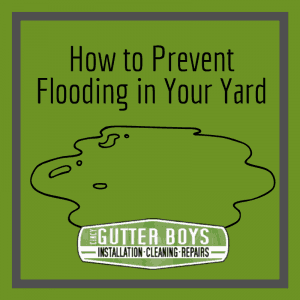How to Prevent Flooding in Your Yard
Limited time offer: 10% off new gutter installation/replacement OR full gutter guard installation
Call or text to schedule your quote today!

With spring comes rain. That’s an unalterable fact of living in the greater Cincinnati area. With spring rains also comes spring flooding, and it seems to get worse every year. Flooding can do all kinds of damage to not only roads and buildings, but to your yard as well. You can prevent this damage with just a few simple steps.
Correct the Grade of Your Yard
The first thing to check when trying to prevent flooding is going to be your yard’s grade. This simply means checking the angle the yard is set at. If you’re fortunate enough for your house to be on a hill with your yard all going downhill, you’ll have no flooding. Few yards have this kind of clear answer though. There’s a good chance your yard looks largely flat, but actually has several divots or dips in various spots around it. These may be due to erosion or past construction. Spotting them may be difficult. Give your lawn a short mowing, and it might be easier to spot, or simply look for where water collects the next time you get a heavy amount of rain. Even out spots by spreading sod or a strategically placed flower bed. If the situation is particularly bad, a landscaping company may be able to help.
No Bald Spots
Making sure the soil in your lawn can absorb rain water in a healthy way goes a long way to preventing flooding. For this reason, you want to make sure you don’t have any bald patches in your lawn. If grass is yellowed or gone in a particular place, not only is water going to accumulate more there, you’re also going to see more damage from erosion. The root structure of plants like grass or trees, allows the soil to absorb water more efficiently and prevents it from being washed away.
Install a Dry Well or Rain Garden
Particularly helpful if your lawn has grading issues that would be too expensive to otherwise address, lawn fixtures like a dry well or a rain garden are both excellent options for increasing the drainage ability of your yard. Deeper depressions are dug into your yard, which will draw water to those spots. Your gutters can be diverted to ensure their drainage is directed there as well. In the case of a drywell, a collection barrel or bucket will be placed in the ground and surrounded by gravel. The well is perforated and allows water to collect, then slowly drain out into your yard. In the case of a rain garden, a plant bed is installed which will include gravel and specially selected plants that adapt well to the periodic collection and drainage of rainwater. Both are solutions that are designed to allow the water to collect in one location of the yard, then be more carefully dispersed into the surrounding soil.
Clean and Repair Your Gutters
Finally, one of the best things you can do to prevent flooding in your yard is to clean and repair your gutters. If your home’s gutters are overflowing due to debris and other blockage, or if your gutters aren’t mounted or pitched correctly, rainwater collecting from your roof isn’t properly collected and dispersed. This leads to rainwater being dumped directly onto the side of your home, alongside your foundation. This allows for flooding and damage to your building. By having your gutters cleaned and inspected by our professional team on a seasonal basis, you protect your home and your yard. Give us a call today to schedule your first visit!